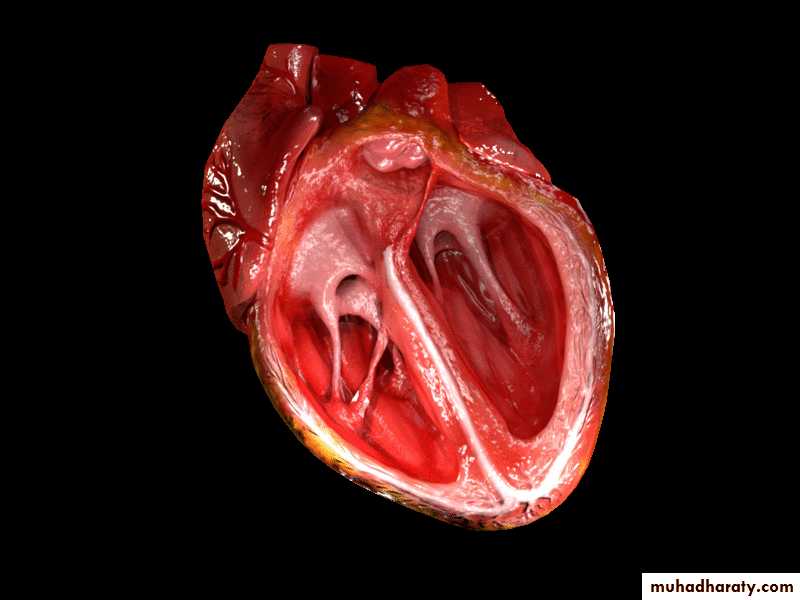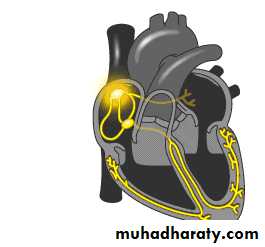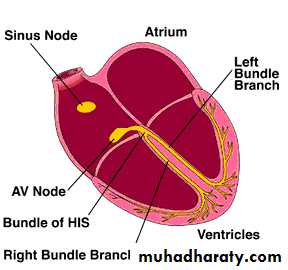Cardiovascular system lecture twoDr. Noor Jawad
• Objective:• Anatomy and Functions of heart valves?
• Intrinsic Control of Heart beat
3.Extrinsic Innervations of the Heart
Heart valves
For the heart to function effectively, blood flow must occur in a one-way direction, moving forward through the chambers of the right heart to the lungs and then through the chambers of the left heart to the systemic circulation.This unidirectional flow is provided by the heart’s valves:
1.The atrioventricular (AV) valves control the flow of blood between the atria and the ventricles . The thin edges of the AV valves form cusps, two on the left side of the heart (i.e., bicuspid or mitral valve) and three on the right side (i.e., tricuspid valve).The AV valves are supported by the papillary muscles, which project from the wall of the ventricles, and the chordae tendineae, which attach to the valve.
2.The aortic and pulmonic valves control the movement of blood out of the ventricles. Because of their half moon shape, they often are referred to as the semilunar valves. The semilunar valves have three little teacup-shaped leaflets. These cuplike structures collect the retrograde, or backward, flow of blood that occurs toward the end of systole, enhancing closure.
Intrinsic Control of Heart beat
The rhythmical contraction of the heart is due to the intrinsic conduction system of the heart, which consist of:1. SA (sinoatrial) node
The sinoatrial (SA) node is the normal pacemaker of the heart and the origin of each normal heartbeat.
The SA node is a collection of specialized myocytes near the site where the superior vena cava enters in the wall of the right atrium.The depolarization begins in the sinoatrial node (SA node), spread rapidly throughout the atria via gap junctions between adjacent myocytes.
2.Atrioventricular Node(A-V node)
The atrioventricular (AV) node is the only electrical communication between the atria and the ventricles. It is characterized by very slow electrical conduction, ensuring that atrial contraction is completed before the ventricles are activated. The AV node is continuous with the atrioventricular bundle (bundle of His).3.Atrioventricular bundle (bundle of His)
The AV bundle carry signals from atrium to the ventricles, in the ventricles the AV bundle divide into right and left bundle branch, these branches then divide into an extensive network of Purkinje fibers.4. Purkinje fibers
Specialized conducting fibers that transmit electrical signals very rapidly to all parts of the ventricular myocardium.
Extrinsic Innervations of the Heart
The excitatory and conductive system of the heart receive innervations from both division of autonomic nervous system. Although the basic heart rate is set by the intrinsic conduction system, fibers of the autonomic nervous system can modify the heart beat :1. The sympathetic nervous system (the “accelerator”) increases both the rate and the force of heartbeat.
2.Parasympathetic slows the heart rate and force of contraction.
heart sounds and Murmurs
Normally, there are two audible heart sounds. The first S1 (“lub”) is associated with closure of the AV valves. The second S2 (“dup”) is associated with closure of the semilunar valves. Two additional heart sounds can be recorded :The third heart sound(S3), is a soft, low-pitched sound heard about one-third of the way through diastole. It coincides with the period of rapid ventricular filling. The third heart sound is normal in children but is not heard in normal adults; in middle-aged or older adults, the presence of S3 indicates volume overload, as in congestive heart failure or advanced mitral or tricuspid regurgitation.
The fourth heart sound(S4),the fourth sound can sometimes be heard immediately before the first sound. The sound is caused by the atrium contracting against, and trying to fill, a stiffened ventricle. The fourth heart sound (S4) is not audible in normal adults, it may be heard in ventricular hypertrophy, where ventricular compliance is decreased.
Other abnormal heart sounds include clicking, caused by abnormal movement of one of the valves, and murmurs, caused by the “whoosh” of blood leaking through an incompletely closed or excessively narrowed (stenotic) valve.
Heart murmurs
are heart sounds produced when blood flows across one of the heart valves that are loud enough to be heard with a stethoscope.Murmurs due to valve lesions may be heard during systole and called systolic murmur or heard during diastole and called diastolic murmur:
• Aortic or pulmonary stenosis causes systolic murmur.
• Mitral or tricuspid insufficiency causes systolic murmur.
• Aortic or pulmonary insufficiency causes diastolic murmur.
• Mitral or tricuspid stenosis causes diastolic murmur.
• The closure of which two valves produces the S1 heart sound?
• SAVE• A. Aortic and mitral valves
• B. Aortic and pulmonic valves
• C. Mitral and tricuspid valves
D. Tricuspid and pulmonic valves
The epicardium:
A) is also known as the parietal pericardium.B) is a layer of cardiac muscle.
C) is the visceral pericardium.
D) lines the heart chambers.
E) is the pacemaker of the heart.










